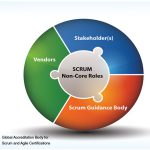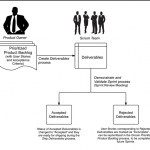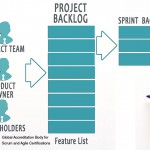How does a Scrum Team Estimate and Commit to User Stories in a Scrum Project?
In this process the Product Owner approves User Stories for a Sprint. Then, the Scrum Master and
Scrum Team estimate the effort required to develop the functionality described in each User Story,
and the Scrum Team commits to deliver the customer requirements in the form of Approved,
Estimated, and Committed User Stories.
Scrum Core Team includes Scrum Team, Scrum Master and Product Owner. Although the entire
Scrum Core Team needs to be involved in creation of the User Stories, it is the Product Owner who
decides the User Stories as he/she creates the project’s initial overall requirements, determines
Product Vision, assesses the viability and ensures delivery of the product or service, decides
minimum marketable release content and ultimately, provides Acceptance Criteria for the User
Stories to be developed in a Sprint. However, the Scrum Team can seek clarifications from the
Product Owner and also provide expert opinion on creation of User Stories.
The User Stories which are input to this process have high level estimates from Create Prioritized
Product Backlog and Create User Stories processes. These estimates are used by the Product Owner
to approve User Stories for the Sprint. It must be noted that it is the Product Owner’s responsibility
to ensure that approved User Stories deliver value and meet the needs and requirements of the
project stakeholders. Once approved, the User Stories are estimated by the team using the various
estimation techniques discussed in this section. After estimation, the team commits to a subset of
approved and estimated User Stories that they believe they can complete in the next Sprint. These
User Stories are approved, estimated, and committed User Stories which will become part of the
Sprint Backlog.
User Group Meetings involve relevant stakeholders, (primarily users or customers of the product),
and provide the Scrum Core Team with firsthand information about the expectations of the users.
This helps in formulating the Acceptance Criteria for the product, and provides valuable insights for
developing Epics. User Group Meetings are vital in the prevention of expensive rework, which may
result from lack of clarity regarding expectations and requirements. These meetings also promote
buy-in for the project, and create a common understanding among the Scrum Core Team and
relevant Stakeholder(s).








Pretty! This was an extremely wonderful article. Many thanks for providing
these details.